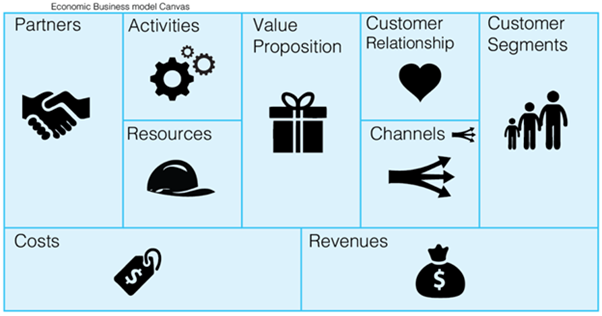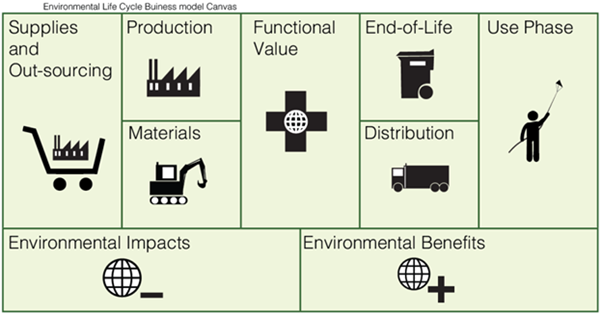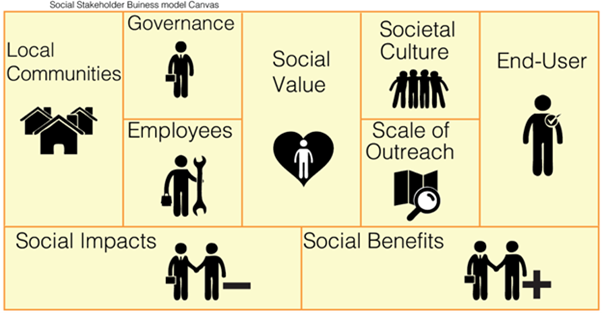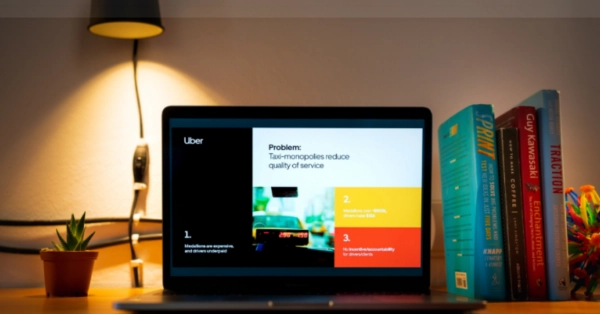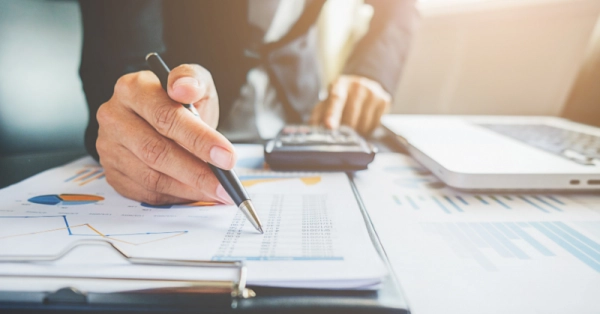To help you design your business model we can use a tool called a business model canvas. This canvas helps us to consider all the necessary building blocks we need to successfully create, capture and deliver value.
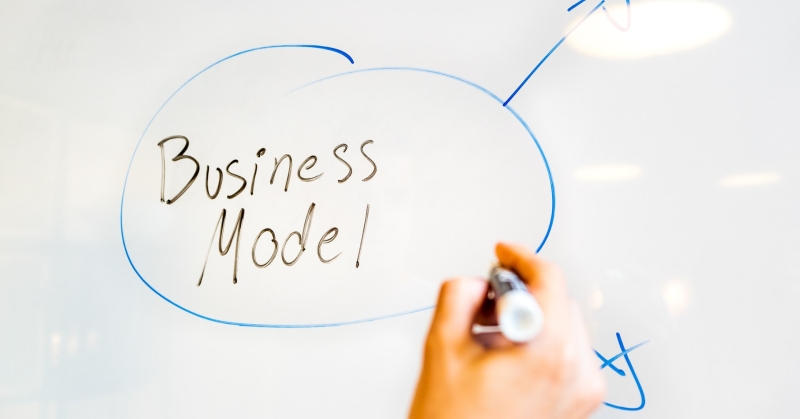
To help you design your business model we can use a tool called a business model canvas. This canvas helps us to consider all the necessary building blocks we need to successfully create, capture and deliver value.
The Business Model Canvas is used for the development of an idea into a viable business model. Is a strategic management tool that lets you visualize and assess your business idea or concept. It’s a one-page document containing nine boxes that represent different fundamental elements of a business.
Why You Need a Business Model Canvas
- The BMC provides a quick overview of the business model and does not have the unnecessary details compared to the traditional business plan.
- The visual nature of the business model canvas makes it easier to refer to and understand by anyone.
- It’s easier to edit and it can be easily shared with employees and stakeholders.
- The business model canvas can be used by large corporations as well as startups with just a few employees.
- It clarifies how different aspects of the business are related to each other.
- You can use a BMC template to guide a brainstorming session on defining your business model effectively.
The Triple Layer Business Model Canvas (TLBMC) is a tool helping us to explore sustainability-oriented business model innovation. It extends the business dimension of the canvas with the addition of an environmental dimension based on life cycle perspective and a social dimension based on stakeholder perspective.
In order to contribute to the sustainable transition of the companies they are building, entrepreneurs must be able to analyze the economic, social and environmental impact of a business model, all of which are included in the triple-layer business model.
Alexandre Joyce and Raymond L. Paquin, researchers from Concordia University Montreal. developed this sustainable business model canvas with the idea that “business model innovation that takes into account a triple bottom line approach will be more sustainable over time”.
How to fill it in
There are nine building blocks in each one of the three layers and also on each of the two new layers. Joyce and Paquin added two new layers while continuing in the structure of the original canvas.
The second layer is built with life cycle thinking approach to the environment and the third layer fosters a stakeholder approach to social issues. You may find this a useful tool but don't feel compelled to complete all the building blocks of the free layers if it does not help you to understand how your idea or product may work.
The first layer is the economic layer referring to the return of financial capital.
This is the traditional business model canvas well used in practice across the globe. An useful way to start is with the customer segments on the right hand side connected to the value proposition at the center. Detail who would be your users, who would be the paying customers and ask yourself if these are the same people or perhaps different. Following these questions, ask yourself what is the value proposition you are offering to them, in other words, which needs are you satisfying or how are you helping them to solve their problems.
Connecting these two elements are our customer relationships and channels. Some useful questions to ask in order to define these points are: how will we get customers? and how will the customers find and buy our offerings?
On the left side, the activities of how your business model will create value are assessed: what are the key activities your business is performing or will perform? For example, do you focus on the production of a certain product or rather on marketing and distribution? What kind of resources are necessary to perform these activities? and do you need certain partners to make the business model successful?
Finally at the bottom of the canvas, you can describe the economic value. Identify all the necessary costs that occur for your operations. On the other hand, consider how your business model makes money. In short, what is the revenue model?
The second layer of the canvas focuses on the environmental aspects of our business model.
At the center of the canvas is the functional value. This is an idea of what are the offerings in terms of physical quantities and is best applied to product offerings. For instance, we are planning to sell liters of ecological milk per day. If your idea cannot be described in these terms, then feel free to leave this blank although we encourage you to research the environmental impact of digital services.
The left side of the canvas evaluates the environmental impact or benefits that the material sourcing production generates as well as supplies and outsourcing. Think about the environmental impact of the key materials you use such as buildings, vehicles or technological infrastructure. A good idea is to think about the water and energy for processes of your production and that of your suppliers, or maybe others associated with biodiversity loss or loss of soil quality.
On the right side the distribution phase and end-of-life elements. Describe the environmental impact or benefits of your offering once it has left your control, until it is not used anymore or is discarded. This may apply to physical products such as books. Maybe you're considering a product that is designed for reuse so you could ask yourself what was the impact of moving the product and how are we minimizing the negative impact of the use phase.
At the bottom the canvas is the value capture for the environment and our landscapes. The questions to ask here are how does our business model negatively affect the environment and how does it positively increase benefits or reduce existing negative impacts. This component is the most important on the canvas and can be used without the other building blocks.
How to use the environmental layer:
Start at the center:
1) Functional value: It is related to volume or quantities of product. For instance: liters of ecological milk per day. If your idea cannot be described in these terms, then feel free to leave this blank.
Go to the left:
2) Materials: for manufacturers, physical materials are purchased and transformed to create more value for the client. Service providers their materials aren't necessarily handed over to the client. Service providers also consume materials in the form of consumables such as paper and gas and in the form of assets such as computers, vehicles and office buildings. It is related to the Key Resources in the BMC
3) Production: for a manufacturer it is the processes that transform mater or assembles parts into a final product. For a service provider: running an IT infrastructure, driving a car or heating and ventilating office spaces and service points.
4) Supplies and Outsourcing: All the different material resources and production activities that are not considered part of the core business. A consumable such as water can come from a supply present in a local river. A good idea is to think about the water and energy you use. Entrepreneurs that can choose to use or to be in a space that uses wind or solar power.
Go to the right:
5) Distribution Once the value proposition is ready for delivery, it is distributed through channels by various transportation methods in various packaging solutions. e type of transportation, the distance traveled, the weight or volume transported. For service providers, employee traveling towards the clients or postal mailings can be considered as part of the distribution. Digital Distribution has an impact on the environment.
6). Use phase: the impact of your user interacting with your product or service. The use phase also includes aspects relevant to maintenance and repair. For service providers, the use phase also requires the consumption of things and energy although.
7) End-Of-Life Begins when the user chooses to end the consumption of the value proposition. For tangible products, there are options such as remanufacturing, repurposing, recycling, disassembly, incineration or disposal. For service providers, the end-of-life applies to the management of the material assets described previously.
Finish at the bottom:
8 and 9) Environmental impact and benefits. List the evidence that your project/business negatively affect the environment and how does it positively increase benefits or reduce existing negative impacts. This component is the most important on the canvas and can be used without the other building blocks. we encourage you to research the environmental impact of digital services.
The third layer considers how we offer, create and deliver value for society, for people.
The center of the canvas asks how we create value for society. You can then consider two important stakeholders on the far left with the local communities and then on the far-right side with the end user. A good question to ask is how our offering improves their quality of life.
Next, we can consider societal culture and scale of outreach to important questions for impactful business models. We can ask how we strengthen positive societal culture and what will be the scale of our societal impact: If it is restricted to a small geographical area, how can you increase your scale of outreach through variable and widespread relationships?
After this, is the turn of two components on the left hand-side: governance and employees. The first one refers to how your business will operate in terms of transparency and organizational structure. In the employees’ section, the idea is to understand what the role of employees in the business is. These elements may be difficult for you to consider at this stage but in time they will need to be carefully considered.
Finally, the bottom part again summarizes the overall social impacts and benefits. Hopefully in your business model the benefits significantly outweigh the negative.
How to use the social layer
Start at the center:
1. This section asks how we create value for society. The social value expresses how a project /business has a purpose to provide a benefit for it stakeholders. Its purpose is larger than insuring its own economic survival. The mission of that project /business should contribute to making the world a better place.
Far right and left:
2. Local Communities and suppliers: the community where the project /business operates. The local communities also includes the suppliers and their communities.
3. End user: The person who consumes the value proposition is the end-user.
A good question to ask is how our offering improves their quality of life.
Near left:
4. Employees: The employee element represents the working conditions and the personal growth initiatives for people working with the project/bussiness.
5. Governance: the organizational structure and leadership approach. how your business will operate in terms of transparency and reporting. .A cooperative, a private owned business and a public company all have different organizational structures and approaches to accomplishing its mission.
Near right
6. Societal culture: The societal culture to which a project /business contributes can be positive, such as promoting diversity and accountability or negative values, such as supporting inequity or short term thinking
7. Scale of outreach: what will be the scale of our societal impact: If it is restricted to a small geographical area, how can you increase your scale of outreach through variable and widespread relationships?
Finish at the bottom
8) and 9) overall social negative impacts and benefits.
When analyzed together, the three layers of the business model make more explicit how an organization creates multiple values: economic (value proposition), environmental (functional value) and social (societal value). They can be read each one independently or stacked on top of each other to understand the relationships between the three segments. For example, the cost and benefits of your business model have also an environmental impact (both positive or negative) and a social impact on your stakeholders.














